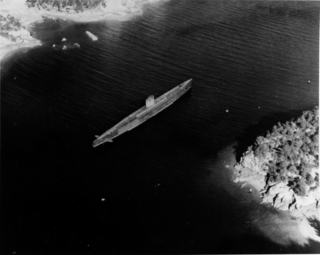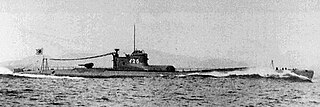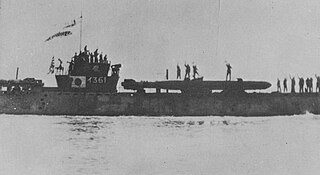
The I-201-class submarines were submarines of the Imperial Japanese Navy during World War II. These submarines were of advanced design, built for high underwater speed, and were known as Sentaka-Dai type submarine or Sentaka type submarine. The type name, was shortened to Suichū Kōsoku Sensuikan Ō-gata.

The Type B1 submarine, also called I-15-class submarine was the first group of boats of the Type B cruiser submarines built for the Imperial Japanese Navy (IJN) during the 1940s. In total 20 were built, starting with I-15, which gave the series their alternative name.
The Kaichū type submarine submarines were double-hulled medium-sized submarines of the Imperial Japanese Navy during World War II. They were derived from the Kaigun-shiki Chū-gata Sensuikan.

The Unryū-class aircraft carriers were World War II Japanese aircraft carriers. Sixteen ships of the class were planned under the Maru Kyū Programme and the Kai-Maru 5 Programme. However, only three of the Unryū-class carriers were completed.
The Kaidai-type submarine was a type of first-class submarine operated by the Imperial Japanese Navy (IJN) before and during World War II. The type name was shortened to Kaigun-shiki Ōgata Sensuikan (海軍式大型潜水艦) Navy Large Type Submarine.

The Akizuki-class destroyers was a class of destroyers of the Imperial Japanese Navy (IJN) built during World War II to complement the Kagerō class, primarily for the role of anti-aircraft screening for carrier battle groups. The class was also designated the Type-B Destroyer, from their plan name. During the war, the class proved to be a very capable multipurpose platform and was well regarded in the IJN.
Japanese destroyers of World War II included some of the most formidable destroyers of their day. This came as a surprise to the Allies, who had generally underestimated Japanese technical capabilities. The Japanese had reassessed their naval needs in the mid-1920s and, placing an emphasis on ship and weapons technology and night-fighting expertise, developed a completely new destroyer design. Subsequent development from one destroyer class to the next was not, however, a smooth progression. Aside from the usual changes arising from experience, serious design faults also came to light and naval treaties imposed restrictions. As a result, the early "Special Type" destroyers required significant changes and the specifications of subsequent classes was reduced in one way or another. Naval treaties were later abrogated in 1937 and so destroyer development continued without regard to limits.

The I-361 class submarine, also called Type-D submarine or Sen'yu/Sen'yu-Dai type submarine was a type of the 1st class submarine in the Imperial Japanese Navy serving during the Second World War. The type name, was shortened to Yusō Sensuikan Ō-gata.
The Cruiser submarine Type-A was a class of submarine in the Imperial Japanese Navy (IJN), which served during the Second World War. The Type-A submarines were built to take a role of the command ships for submarine squadrons. For this reason they had equipment for a headquarters, better radio facilities and a floatplane.
The Cruiser submarine Type-C was one of the first classes of submarine in the Imperial Japanese Navy (IJN) to serve during the Second World War. Type-C submarines were better armed than the Type-A and Type-B. The Type-Cs were also utilized as Kō-hyōteki or Kaiten mother ships, for this reason they were not equipped with aviation facilities.
The Cruiser submarine Type-B was a class of submarine in the Imperial Japanese Navy (IJN) which served during World War II. The Type-B submarines were similar to the Type-A apart from not having the headquarters installation.
The Junsen type submarine was a ship class of submarines of the Imperial Japanese Navy (IJN). There were four submarine designs of the Junsen type: J1, a modified J1, J2 and the J3.

The I-351-class submarine was a class of tanker/transport submarines built for the Imperial Japanese Navy (IJN) during World War II. The IJN called this type of submarine Senho type submarine. The type name, was shortened to Hokyū Sensuikan. The IJN designed these submarines to support flying boats in forward areas. By the time the first submarine was finished, this capability was no longer needed and she was converted into a tanker. That boat, I-351, was sunk on the return leg of her second voyage in 1945; the second boat, I-352, was destroyed by an American air raid before she was completed. Four additional submarines were planned, but were cancelled before they were laid down.

The Ha-101-class submarine was a transport submarine built for the Imperial Japanese Navy (IJN) during World War II. The IJN planned to build 12 boats, but only 10 vessels were completed by the end of the war. The IJN called these submarines Sen'yu-Shō type submarine. The type name, was shortened to Yusō Sensuikan Ko-gata.

The Ro-100-class submarine was a group of medium-sized coastal submarines built for the Imperial Japanese Navy (IJN) during World War II. The IJN official designation for this class was Ko type submarine or Senshō type submarine. They are also known as Type KS submarine. The type name was shortened to Sensuikan Ko-gata.

The Ha-201-class submarine were a class of small submarines designed for the Imperial Japanese Navy (IJN). They were first deployed in 1945, but never saw combat. The Ha-201's were designed from the outset to have high underwater speed and were based on the earlier Submarine No.71 prototype. The official designation of the submarine was Sentaka-Shō type submarine. The type name was shortened to Suichū Kōsoku Sensuikan Ko-gata.
Imperial Japanese Navy ship classifications went through various changes between 1871 and 1945, as technology changed and new ship classes were added while those that became obsolete were discontinued. There were efforts to translate some ships' classes that were imported or in use by other navies, while incorporating any classification system into Japanese language conventions and maintaining an internal consistency.
I-52, later I-152, was the second prototype of the Kaidai-class submarine of the Imperial Japanese Navy. Commissioned in 1925, she became a training ship in 1935 and was decommissioned in 1942 during the early months of the Pacific campaign of World War II. She subsequently served as the stationary training hulk Haikan No. 14 and was scrapped after the war.
Murakumo was the lead ship of six Murakumo-class destroyers, built for the Imperial Japanese Navy in the late 1890s. Murakumo took part in the Japanese response to the Boxer Rebellion (1900), saw action in several major engagements during the Russo-Japanese War (1904–1905), and served during World War I (1914–1918).








